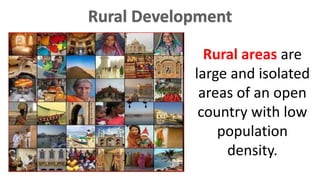Rural Development
- 1. Rural areas are large and isolated areas of an open country with low population density.
- 2. Rural Development is the process of improving the social, economic, and cultural conditions of a village or small town.
- 3. To Build To improve To generate Infrastructure Public Service Communication Health Education Living condition Employment Farm & storage Economical activities
- 8. What World Health Organizations Says? According to the World Health Organization, it is estimated that 98,000 people in India die from diarrhea each year. The lack of adequate sanitation, nutrition and safe water has significant negative health impacts.
- 10. People Died Because Of Hunger Source : FAO estimates of 2006 50% 8% 20% 22% Marginal Farmers Pastoralists/Fishermen Urban Poor Landless Rural Poor 37% 4% 24% 4% 6% 25% Asia And Pacific Others Sub - Saharan North East And North Africa Latin America And caribbean India
- 12. What World Bank Says?
- 14. PEOPLE RELATED PROBLEMS • 1.Traditional way of thinking. • 2.Poor understanding. • 3.Low level of education to understand developmental efforts and new technology. • 4.Deprived psychology and scientific orientation. • 5.Lack of confidence. • 6.Poor awareness. • 7.Existence of unfelt needs. • 8.Personal ego.
- 15. AGRICULTURERELATED PROBLEM 1.Lack of expected awareness ,knowledge ,skill and attitude. 2.Unavailability of inputs. 3.Poor marketing facility. 4.Insufficient extension of staff and services. 5.Multidimensional tasks to extension personnel. 6.Small size of landholding .7.Division of land. 8.Unwillingness to work and stay in rural areas.
- 16. INFASTRUCTRAL RELATED PROB. • Poor infrastructure facilities like-: • 1.Water • 2.Electricity • 3.Transport • 4.Educational institutions • 5.Communication • 6.Health • 7.Employment • 8.Storagefacility etc.
- 17. ECONOMIC PROBLEMS • 1.Unfavourable economic condition to adopt high cost technology. • 2.High cost of inputs. • 3.Underprivileged rural industries
- 18. LEADERSHIP RELATED PROBLEM 1.Leadership among the hands of inactive and incompetent people. 2.Selfinterest of leaders. 3.Biased political will
- 19. ADMINISTRATIVE PROBLEMS 1.Political interference. 2.Lack of motivation and interest. 3.Unwillingness to work in villages. 4.Improper utilization of budget. 5.No proper monitoring of programs and lacking their implementation.
- 21. 'National Rural Employment Guarantee Act'2005 (NREGA) • Act guarantees 100 days of employment in a financial year to every household social safety net for the vulnerable groups and an opportunity to combine growth with equity Structured towards harnessing the rural work-force, employment for the area for future growth employment and self-sufficiency Operationalized from 2nd February, 2006 in 200 selected districts, extended to 130 more districts in 2007-08. • The remaining districts (around 275) of the country under the ambit of NREGA from 1st of April, 2008
- 22. Swarnjayanti Gram Swarozgar Yojana (SGSY) • Self employment programme for the rural poor. • The assisted families (Swarozgaris) may be individuals or groups (Self-Help Groups). • Emphasis is on the group approach • To bring the assisted poor families above the poverty line by providing them income generating assets through a mix of bank credits and government subsidy. • Organization of poor into Self-Help Groups and taking care of training, credit, technology infrastructure and marketing. • Implemented by the District Rural Development Agencies (DRDAs) with the active participation of Banks, the line Departments, and NGO’s
- 23. Pradhan Mantri Gram Sadak Yojana (PMGSY) • Launched December, 2000 100% centrally sponsored scheme to provide connectivity to unconnected habitations Road connectivity to all habitations with a population of thousand (500 in case of hilly or tribal areas) with all weather roads by 2009 • lead to rural employment opportunities, better access to regulated and fair market, better access to health, education and other public services • Bridge the rural-urban divide and pave the path of economic growth.
- 24. The scheme provides for free of cost connection to all rural households living below poverty line. Further, there will no discrimination in the hours of supply between rural and urban areas. The scheme also lays special emphasis on sustainability of rural supply through collection of the cost of electricity from the beneficiaries. The scheme has a target of electrifying 1,25,000 un-electrified villages and giving access to 7.8 crore uncovered rural households in next 5 years.



























